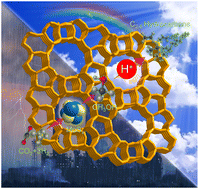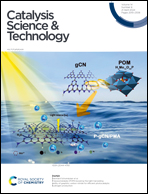Bifunctional catalyst MoSx@H-Beta for highly selective conversion of CO2 to C2–6 hydrocarbons†
Abstract
We report here a bifunctional catalyst MoSx@H-Beta for highly selective conversion of CO2 to C2–6 hydrocarbons. The catalyst is prepared using a two-step solid reaction method. Firstly, MoOx@H-Beta, with MoOx+ clusters at the exchangeable site of the zeolite, is obtained by sublimating and reacting MoO3 with zeolitic H+ sites during heating. Then, MoOx@H-Beta is converted into MoSx@H-Beta through a vulcanization reaction, by heating the mixture of MoOx@H-Beta and sulphur powder in flowing 5 vol% H2/N2. During the vulcanization of molybdenum oxide clusters, the zeolitic H+ sites are recovered. Two types of active sites, i.e., molybdenum sulfide clusters and the zeolitic H+ sites, are intimately encapsulated in channels of the MoSx@H-Beta catalyst. Over the catalyst, more than 75% of selectivity to C2–6 hydrocarbons in organic products at ∼13% of CO2 conversion is obtained under the optimal reaction conditions of 300 °C, 4 MPa, CO2/H2 = 1/3, and 1600 mL g−1 h−1. The characterization results indicate that CO2 is firstly hydrogenated into intermediate CH3OH over the MoSx sites, which is subsequently converted into C2–6 hydrocarbons over the adjacent Brønsted acid sites in channels of H-Beta zeolite. The MoSx clusters are highly dispersed and occupied in channels of H-Beta zeolite, exhibiting an excellent stability during 200 h on stream. The cooperative mechanism between molybdenum sulfide clusters and Brønsted acid sites of H-Beta zeolite constitutes the nature of a bifunctional catalyst, demonstrated by theoretical calculations, well accounting for its high catalytic performance.



 Please wait while we load your content...
Please wait while we load your content...